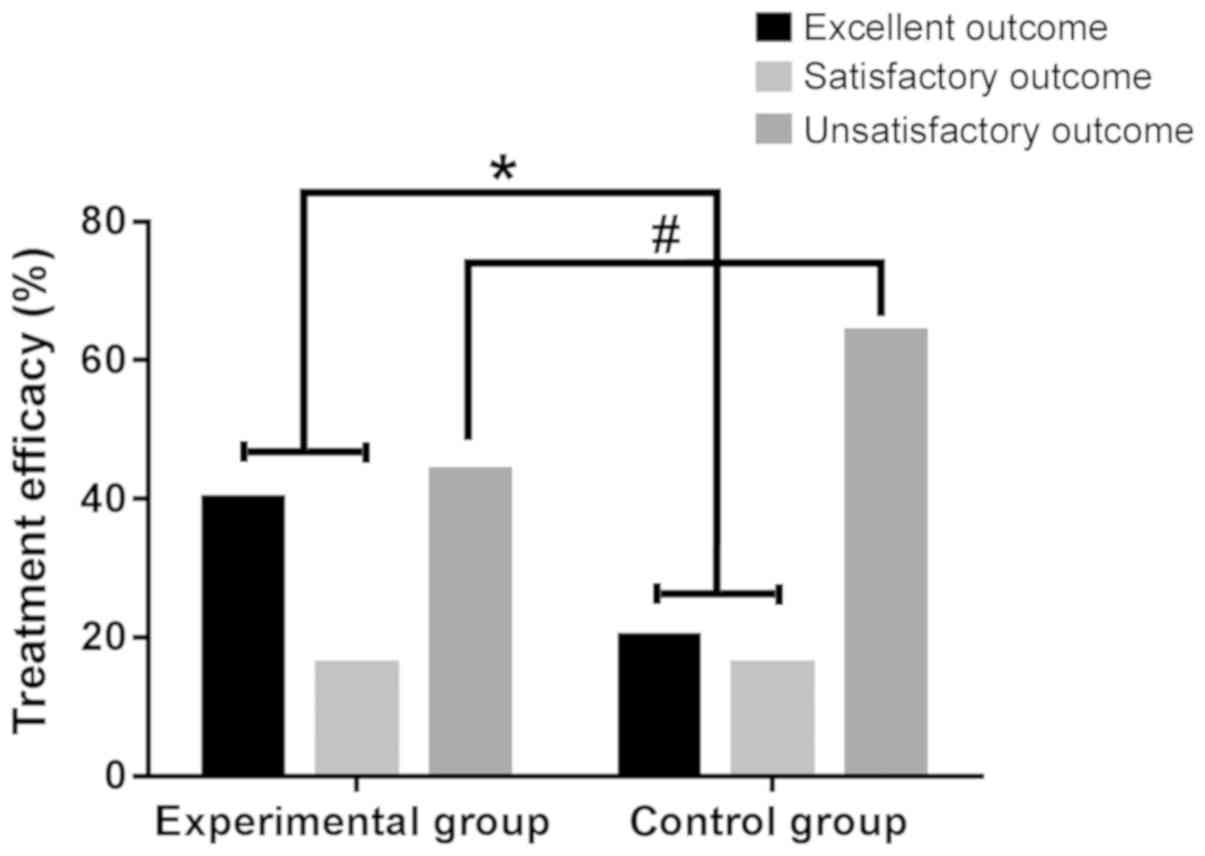|
1
|
Hyder AA, Wunderlich CA, Puvanachandra P,
Gururaj G and Kobusingye OC: The impact of traumatic brain
injuries: A global perspective. NeuroRehabilitation. 22:341–353.
2007.PubMed/NCBI
|
|
2
|
Ommaya AK and Gennarelli TA: Cerebral
concussion and traumatic unconsciousness. Correlation of
experimental and clinical observations of blunt head injuries.
Brain. 97:633–654. 1974. View Article : Google Scholar : PubMed/NCBI
|
|
3
|
McCrea M, Iverson GL, McAllister TW,
Hammeke TA, Powell MR, Barr WB and Kelly JP: An integrated review
of recovery after mild traumatic brain injury (MTBI): Implications
for clinical management. Clin Neuropsychol. 23:1368–1390. 2009.
View Article : Google Scholar : PubMed/NCBI
|
|
4
|
Graham DI, Adams JH and Doyle D: Ischaemic
brain damage in fatal non-missile head injuries. J Neurol Sci.
39:213–234. 1978. View Article : Google Scholar : PubMed/NCBI
|
|
5
|
Bryant RA, O'Donnell ML, Creamer M,
McFarlane AC, Clark CR and Silove D: The psychiatric sequelae of
traumatic injury. Am J Psychiatry. 167:312–320. 2010. View Article : Google Scholar : PubMed/NCBI
|
|
6
|
Taylor CA, Bell JM, Breiding MJ and Xu L:
Traumatic brain injury-related emergency department visits,
hospitalizations, and deaths - United States, 2007 and 2013. MMWR
Surveill Summ. 66:1–16. 2017. View Article : Google Scholar : PubMed/NCBI
|
|
7
|
Ommaya AK, Goldsmith W and Thibault L:
Biomechanics and neuropathology of adult and paediatric head
injury. Br J Neurosurg. 16:220–242. 2002. View Article : Google Scholar : PubMed/NCBI
|
|
8
|
Zhang J, Williams MA and Rigamonti D:
Genetics of human hydrocephalus. J Neurol. 253:1255–1266. 2006.
View Article : Google Scholar : PubMed/NCBI
|
|
9
|
Bering EA Jr and Sato O: Hydrocephalus:
Changes in formation and absorption of cerebrospinal fluid within
the cerebral ventricles. J Neurosurg. 20:1050–1063. 1963.
View Article : Google Scholar : PubMed/NCBI
|
|
10
|
Dixon GR, Friedman JA, Luetmer PH, Quast
LM, McClelland RL, Petersen RC, Maher CO and Ebersold MJ: Use of
cerebrospinal fluid flow rates measured by phase-contrast MR to
predict outcome of ventriculoperitoneal shunting for idiopathic
normal-pressure hydrocephalus. Mayo Clin Proc. 77:509–514. 2002.
View Article : Google Scholar : PubMed/NCBI
|
|
11
|
Battal B, Kocaoglu M, Bulakbasi N, Husmen
G, Tuba Sanal H and Tayfun C: Cerebrospinal fluid flow imaging by
using phase-contrast MR technique. Br J Radiol. 84:758–765. 2011.
View Article : Google Scholar : PubMed/NCBI
|
|
12
|
Schoenbaum SC, Gardner P and Shillito J:
Infections of cerebrospinal fluid shunts: Epidemiology, clinical
manifestations, and therapy. J Infect Dis. 131:543–552. 1975.
View Article : Google Scholar : PubMed/NCBI
|
|
13
|
Reddy GK, Bollam P, Caldito G, Willis B,
Guthikonda B and Nanda A: Ventriculoperitoneal shunt complications
in hydrocephalus patients with intracranial tumors: An analysis of
relevant risk factors. J Neurooncol. 103:333–342. 2011. View Article : Google Scholar : PubMed/NCBI
|
|
14
|
Zhang J, Qu C, Wang Z, Wang C, Ding X, Pan
S and Ji Y: Improved ventriculoatrial shunt for cerebrospinal fluid
diversion after multiple ventriculoperitoneal shunt failures. Surg
Neurol. 72 (Suppl 1):S29–S34. 2009. View Article : Google Scholar : PubMed/NCBI
|
|
15
|
Grosfeld JL, Cooney DR, Smith J and
Campbell RL: Intra-abdominal complications following
ventriculoperitoneal shunt procedures. Pediatrics. 54:791–796.
1974.PubMed/NCBI
|
|
16
|
Murtagh F and Lehman R: Peritoneal shunts
in the management of hydrocephalus. JAMA. 202:1010–1014. 1967.
View Article : Google Scholar : PubMed/NCBI
|
|
17
|
Limbrick DD Jr, Baird LC, Klimo P Jr,
Riva-Cambrin J and Flannery AM; Pediatric Hydrocephalus Systematic
Review and Evidence-Based Guidelines Task Force, : Pediatric
hydrocephalus: systematic literature review and evidence-based
guidelines. Part 4: Cerebrospinal fluid shunt or endoscopic third
ventriculostomy for the treatment of hydrocephalus in children. J
Neurosurg Pediatr. 14 (Suppl 1):30–34. 2014. View Article : Google Scholar : PubMed/NCBI
|
|
18
|
Hebb AO and Cusimano MD: Idiopathic normal
pressure hydrocephalus: A systematic review of diagnosis and
outcome. Neurosurgery. 49:1166–1186. 2001. View Article : Google Scholar : PubMed/NCBI
|
|
19
|
Constine LS, Konski A, Ekholm S, McDonald
S and Rubin P: Adverse effects of brain irradiation correlated with
MR and CT imaging. Int J Radiat Oncol Biol Phys. 15:319–330. 1988.
View Article : Google Scholar : PubMed/NCBI
|
|
20
|
Cao M and Wu JI: Camk2a-Cre-mediated
conditional deletion of chromatin remodeler Brg1 causes perinatal
hydrocephalus. Neurosci Lett. 597:71–76. 2015. View Article : Google Scholar : PubMed/NCBI
|
|
21
|
Walker WC and McDonald SD: Does neurologic
examination during inpatient rehabilitation help predict global
outcome after nonpenetrating traumatic brain injury? PM R. 3:6–12.
2011. View Article : Google Scholar : PubMed/NCBI
|
|
22
|
McDonald S and Flanagan S: Social
perception deficits after traumatic brain injury: Interaction
between emotion recognition, mentalizing ability, and social
communication. Neuropsychology. 18:572–579. 2004. View Article : Google Scholar : PubMed/NCBI
|
|
23
|
Yang XF, Wen L, Shen F, Li G, Lou R, Liu
WG and Zhan RY: Surgical complications secondary to decompressive
craniectomy in patients with a head injury: A series of 108
consecutive cases. Acta Neurochir (Wien). 150:1241–1248. 2008.
View Article : Google Scholar : PubMed/NCBI
|
|
24
|
Rekate HL: A contemporary definition and
classification of hydrocephalus. Semin Pediatr Neurol. 16:9–15.
2009. View Article : Google Scholar : PubMed/NCBI
|
|
25
|
Chumas PD, Armstrong DC, Drake JM,
Kulkarni AV, Hoffman HJ, Humphreys RP, Rutka JT and Hendrick EB:
Tonsillar herniation: The rule rather than the exception after
lumboperitoneal shunting in the pediatric population. J Neurosurg.
78:568–573. 1993. View Article : Google Scholar : PubMed/NCBI
|
|
26
|
Chung JJ, Yu JS, Kim JH, Nam SJ and Kim
MJ: Intraabdominal complications secondary to ventriculoperitoneal
shunts: CT findings and review of the literature. AJR Am J
Roentgenol. 193:1311–1317. 2009. View Article : Google Scholar : PubMed/NCBI
|
|
27
|
Pudenz RH and Foltz EL: Hydrocephalus:
Overdrainage by ventricular shunts. A review and recommendations.
Surg Neurol. 35:200–212. 1991. View Article : Google Scholar : PubMed/NCBI
|















